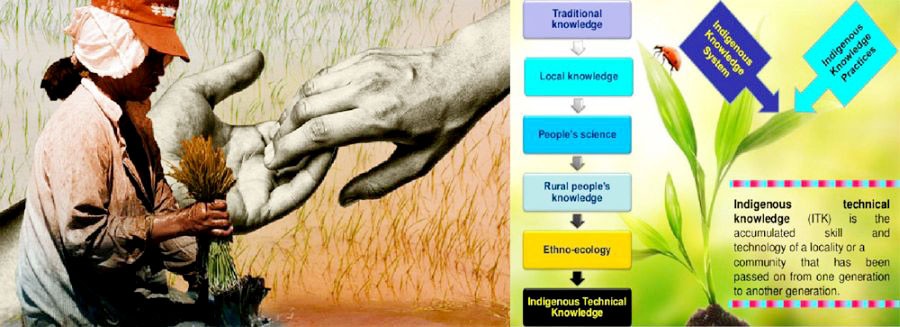
Dr Hannah Krujia
ACTO Agronomy, KVK Phek
The Indigenous Technical Knowledge (ITK) is the local knowledge that is unique to a given culture or society where its knowledge passes from generation to generation. It is the knowledge that people have gained through inheritance from their ancestors. Wang (1988) defined ITK as “the sum total knowledge and practices which are based on peoples accumulated experiences in dealing with situations and problems in various aspects of life and such knowledge and practices are special to a particular culture.” ITK is stored in people's memories and activities, and is expressed in the form of stories, songs, folklore, proverbs, dances, myths, cultural values, beliefs, rituals, community laws, local language and taxonomy, agricultural practices, equipment, materials, plant species and animal breeds. ITK is shared and communicated orally, by specific examples and through culture. An African proverb says "When an old knowledgeable person dies, a whole library dies” indicating the importance of ITKs.
The basic characteristics of the ITKs provide for conservation and efficient utilization of resources by being eco-friendly, less capital intensive, cost effective, and efficient byproduct and waste recycling and use. Most of the ITKs are location – specific, using locally available materials and are products of informal research. ITKs are found to be socially desirable, economically affordable, sustainable, and involves minimum risk to users and widely believed to conserve resources. Thus, ITK provides basis for problem solving strategies for local communities. In addition, the use of ITK assures that the end user of specific development projects are involved in developing technologies appropriate to their needs (Warren, 1991).
Some of the ITK’s practiced in crop husbandry are as follows:
* Stubbles are burned in the field for controlling pests.
* Neem leaves are buried in soil for termite control
* Ash is applied in seedbeds and in the field of paddy nursery before sowing to control insect pest attack
* Residues of Tobacco are incorporated into soil to control termites.
* Deep ploughing is taken up in summer in drylands for avoiding hard pan in soil, improving water holding capacity and pest control
* The filtered extract of well crushed cloves of garlic (1/2 kg) mixed in kerosene and left overnight, filtered solution of 50 grams crushed chillies in one litre of water and 100 grams of detergent powder dissolved in sufficient quantity of water is mixed. The mixture of these three solutions is used at the rate of 25 ml in 16 litres of water and sprayed on the pigeon pea crop for controlling pod borer. (It is found scientifically that garlic has volatile sulphur containing oil which is vaporized with increased temperature, Chillies contain capsaicin which irritates skin, the detergent helps in spread of solution and adherence to crop.)
* Cotton seeds are dipped in cow dung slurry and shade dried before sowing to facilitate better germination.
* Pulse seeds are treated with red earth slurry and shade dried for prevention of storage pests and better germination.
* Sheep and Goat are penned in fields prior to ploughing, to enrich fertility status of the soil.
* Intercropping Sesbania with Tomato during summer is found to enhance the yield of Tomato crop.
* Intercropping castor, Bhendi and Cluster beans with Cotton reduced pest and disease incidence in Cotton.
* Using Neem and Eucaluptus leaves in storage bins controlled damage by storage pests in cereals.
* 6-8 kg of freshly collected green neem leaves (Azardirachta indica) are boiled in 10 liters of water until the liquid turns dark brown. After 10-12 hours, this is mixed with 80-100 liters of clean water and sprayed on the fields for controlling the girdle beetle (Oberia brevis), Bihar hairy caterpillar (Dicrisia oblique) and other pests in soya bean.
* 1.5 - 2 kg of dry tobacco leaves are placed in 5-6 litres of water and boiled until the liquid is reduced to 1-1.5 liters and has turned dark black. After 10-12 hours the solution is filtered and mixed with 80-90 liters of fresh water to spray one hectare, early in the morning to control the larvae of gram pod borer (Heliothis armigera).
Conclusion
The Indigenous Technical Knowledge (ITK) could be helpful towards the achievement of food security at the household level and could also make contributions to the development of sustainable adaptation policies to assist rural based communities. The framework of local knowledge systems combining traditional skills, culture and artifacts with modern skills, perspectives and tools is not something that has happened only in the recent past. From time immemorial, new crops were introduced from one part of the world to another and cultural and ecological knowledge systems evolved while adapting these crops, animals, trees, tools, etc., into their new contexts. This is an ongoing process. Therefore, the need of the hour is to create a foundation at the national level that helps in building national register of innovations, file applications for patents, and provide micro-venture capital support for enterprises based on indigenous knowledge and non-material incentives such as recognizing or honoring innovators and community holding indigenous knowledge.
Reference: 105th FoCARS - N. Sandhya Shenoy (Principal Scientist, XSM Division, NAARM)




